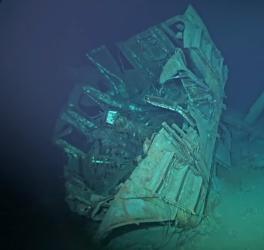 The RV Petrel continues its amazing streak of underwater discoveries. Now, it has located the wreckage of what is believed to be the USS Johnston at a depth of 20,400 ft in the Philippine Sea. The wreck is believed to be the deepest wreck of a warship ever discovered. According to Guinness World Records, the deepest wreck before the discovery of the USS Johnston was a German vessel discovered at 18,904ft.
The RV Petrel continues its amazing streak of underwater discoveries. Now, it has located the wreckage of what is believed to be the USS Johnston at a depth of 20,400 ft in the Philippine Sea. The wreck is believed to be the deepest wreck of a warship ever discovered. According to Guinness World Records, the deepest wreck before the discovery of the USS Johnston was a German vessel discovered at 18,904ft.
The destroyer was sunk in the Battle of Samar on October 25, 1944. We recently posted about the 75th anniversary of the battle in which, against all odds, a handful of US Navy destroyers and destroyer escorts drove off a Japanese fleet of 23 ships, including battleships and heavy cruisers, saving the landings at Leyte Gulf from likely destruction.
The USS Johnston lead the attack against the overwhelming Japanese force. The Johnston seriously damaged and forced the withdrawal of a Japanese heavy cruiser as well as hitting several other Japanese cruisers and destroyers before the Johnston was sunk herself, with the loss of 186 sailors.
The wreckage sighted has not yet been confirmed as the USS Johnston. “This wreck is either the Johnston or the USS Hoel,” the Petrel team said. “This wreck is in the southern part of where the battle took place and this is one of the reasons why we believe this is the Johnston, because she sank later, after Hoel did.”
Deepest shipwreck found by Vulcan’s R/V Petrel
Thanks to David Rye for contributing to this post.

The defining archetype of the hoary old term “blown to fragments.” The brief view of the debris field seem to reveal only… debris.
Astounding that so relatively many were pulled out alive, considering the condition of the steel itself. It’s just hard to imagine anybody surviving the environment that shredded those turrets, left 1/3rd of the bridge* as a twisted chunk lying on the bottom.
* there’s a portion of the video puzzling over identity of section containing a closely-spaced row of ports containing glass fragments with a heavy concentration of cabling; seems as though ti could only have been part of the bridge?
Given the number of times that the Johnston was hit by shells from battleships and heavy cruisers, it may not be surprising that she broke up. Add the stresses of sinking through three miles of ocean before hitting bottom and it may not be a surprise that all that was left was a debris field.